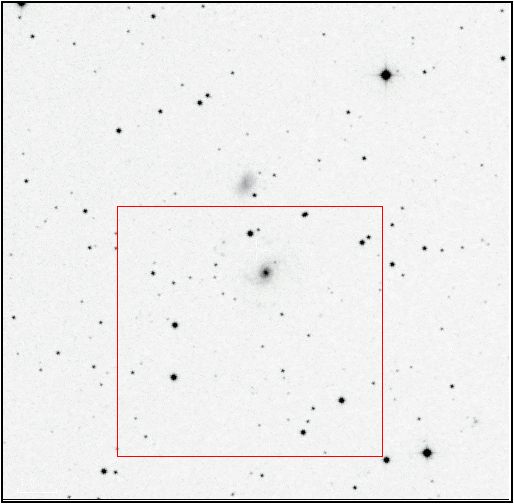
 Copyright © Michael Richmond.
This work is licensed under a Creative Commons License.
Copyright © Michael Richmond.
This work is licensed under a Creative Commons License.
In a portion of the sky near coordinates RA 03:57:00 and Dec +16:30 (J2000), there is a pair of unremarkable galaxies. This picture shows the two of them, together with a sprinkling of stars in our own Milky Way Galaxy. The image is roughly 13 arcminutes on a side, and is oriented with North up and East to the left.

Pay special attention to the area within the red box ....
The Katzmann Automatic Imaging Telescope (KAIT) searches for supernovae from its perch high on Mount Hamilton, overlooking the San Francisco Bay. This portion of the sky falls into part of its regular survey area, and so it has taken many pictures of the region over the past few years. On December 28, 2003, it noticed that something looked different. Here's the KAIT image -- it covers the area shown in the red box of the chart. Click on the KAIT image to blink it with a reference image.
Can you find the new object? Click on the image below to blink it against the reference image. (Actually, people with sharp eyes can find two objects which don't appear on the reference image! Pay attention to the one close to the galaxy.)
Could this be a supernova? In order to confirm it as a new star, one needs a second image taken some time later. If the object is an asteroid, it will move away from its initial position; a supernova, on the other hand, will remain in the same spot.
The next opportunity for an image was January 10. A picture taken just before 5:00 UT showed the new object again. Click on the image below to blink it against the reference image.
Aha! It must be a supernova. The KAIT team announced the discovery in IAU Circular 8266:
SUPERNOVA 2003lr IN UGC 2904
Further to IAUC 8262, H. Pugh and R. J. Foley report the LOSS
discovery of an apparent supernova on unfiltered KAIT images taken
on 2003 Dec. 28.2 UT (mag 18.3) and 2004 Jan. 10.2 (mag 17.8). The
new object is located at R.A. = 3h56m59s.00, Decl. = +16o29'37".5,
which is 15".9 east and 33".3 north of the center of UGC 2904.
Nothing was visible at this location on an image taken on 2003 Dec.
22.3 (limiting mag 19.5).
About a month later, on February 13, 2004, the KAIT team used the Keck-I 10m telescope to take a spectrum of the object. When they pointed the telescope to this part of the sky, they saw on the guider screen (image at left below) the spiral galaxy, a nearby bright star, and, just between them, the extra point of light. On the right is the corresponding section of the reference image.
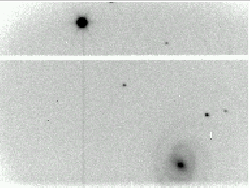
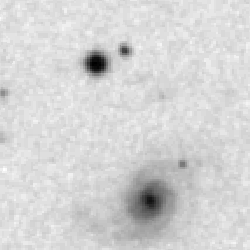
(Note that the plate scale has changed, since we've moved from a 0.6-m telescope to a 10-m telescope!)
So, they placed the slit over the new object and acquired a spectrum. However, the spectrum was NOT what they expected. Instead of showing the strong, wide absorption lines typical of a supernova, it instead showed an ordinary stellar spectrum with narrow absorption lines; it looked like an ordinary G dwarf star ... like our Sun, in fact.
If one looks very carefully at the positions of the candidate (taken by KAIT) and the position of the object who spectrum was taken at Keck, one sees a slight difference. Look at the images below:
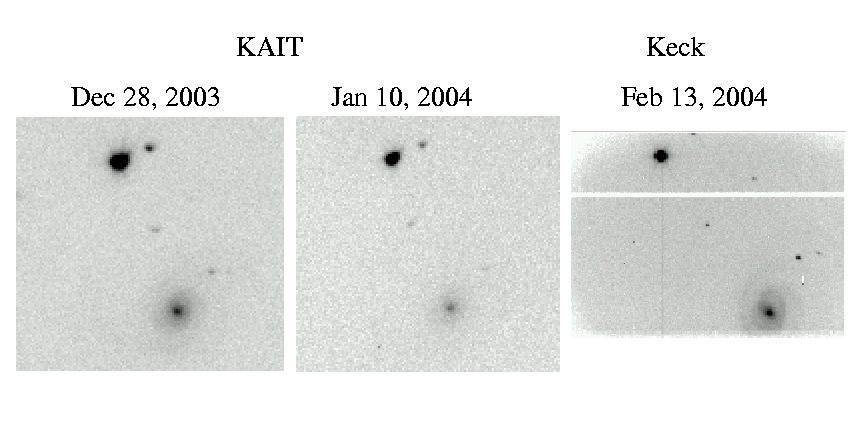
Does the "new star" really appear in exactly the same place on all three nights? Perhaps it will help if we draw a line joining the center of the galaxy to the nearby bright star, to act as a reference.
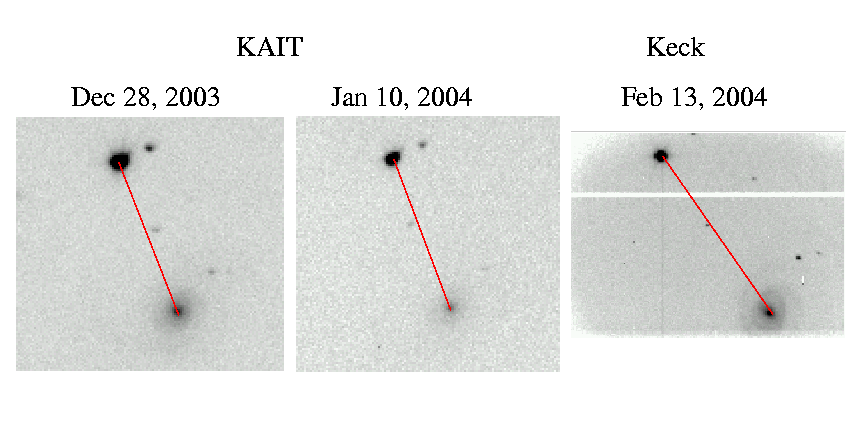
It turns out that the reason the spectrum of this supernova resembled the solar spectrum is because ... it WAS the solar spectrum. That was no supernova -- it was an asteroid, reflecting the light of the Sun.
"But wait!" you may cry, "if it was an asteroid, why wasn't it moving? Why did KAIT see it in the same place in images taken two weeks apart? Why did it move by just a tiny little bit by the time of the Keck spectrum? Is this some special sort of slow-moving asteroid, a Kuiper Belt Object, or an Oort comet?!"
Nope. It's just a case of bad luck. Supernova 2003lr turns out to have been three different asteroids!
On December 28, 2003, the asteroid 42805 (1999 JU1) happened to be moving through this portion of the sky. KAIT took its picture just as it passed between the two galaxies. The chart below shows its path from three and a half hours before the KAIT image to three and half hours later.
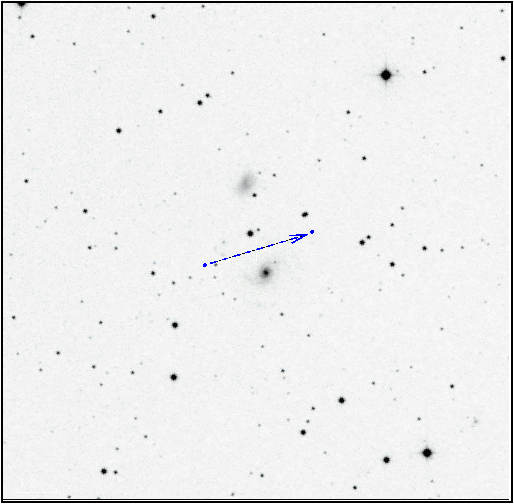
On January 10, 2004, a different asteroid, 42671 (1998 HQ_68) happened to be gliding through this part of the sky. Its motion over the course of two days is shown below; the unusual wiggly path, caused by diurnal parallax, is a sign that this asteroid was close to its stationary point.
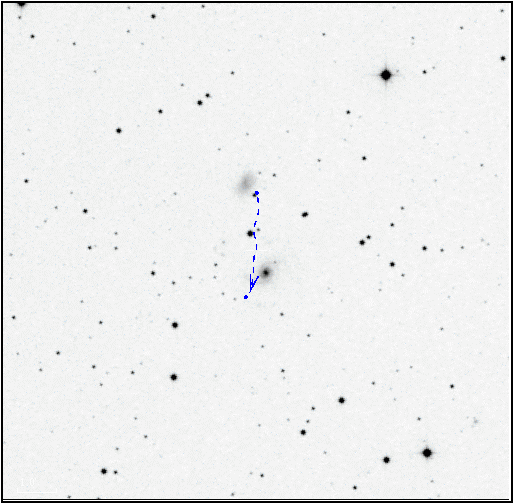
KAIT was just unlucky enough to take pictures at the exact times when the two asteroids appeared to be in exactly the same place!
And then, on February 13, 2004, yet another asteroid, 23017 (1999 VQ_190), happened to fly between these galaxies as the Keck telescope was looking. The arrow below shows its motion over a seven-hour period. Note that it is moving in a retrograde direction.
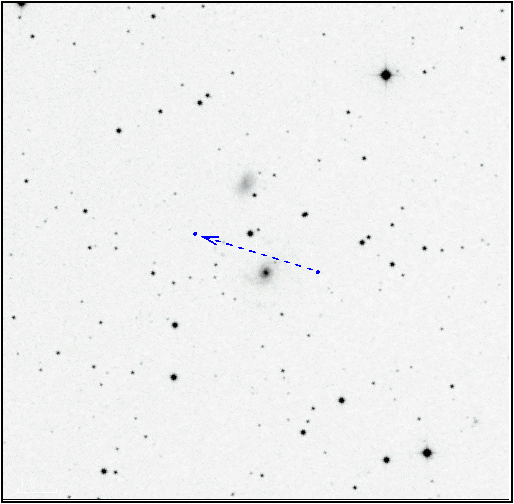
What are the chances that three different asteroids will sit in the exact same spot (to within a few arcseconds) at three arbitrary times? Not very probable ... but that's what happened!
And so, the KAIT team made a sad announcement in IAU Circular 8288:
NO SUPERNOVA 2003lr
Li, Filippenko, Chornock, and Foley also report that there is
no supernova 2003lr (cf. IAUC 8266) in UGC 2904. Further
inspection of the KAIT images taken on 2003 Dec. 28.23 and 2004
Jan. 10.19 UT reveals that two different minor planets were imaged
at nearly the same location (7" positional difference): (42805)
1999 JU_1 on Dec. 28, and (42671) 1998 HQ_68 on Jan. 10.
Remarkably, a Keck-I CCD spectrum of an object close to the
putative position of the supernova, obtained on 2004 Feb. 13.32,
revealed yet another minor planet, (23017) 1999 VQ_190. A KAIT
image taken on Jan. 16.2 showed nothing at the position of 2003lr
(limiting mag about 19.0).
Sigh. Those rotten "vermin of the sky."(*)
(*) I have managed to track this phrase
down to an address given in awarding the Bruce Medal
of the Astronomical Society of the Pacific to
Professor Max Wolf, in the year 1930.
You can read the address yourself in
PASP 42, 5 (1930).
Look on page 10, where the speaker, Frederick Seares,
writes,
Now, as far as I can tell, the PASP article's
spelling of "Wiess" is incorrect.
Edmund Weiss (1837-1917) was Director of the Observatory
in Vienna in the late nineteeth century.
Take a look at a portrait of him.
... He must have had a little of the feeling
expressed by Wiess of Vienna, who in conversation
sometimes referred to the asteroids as "those vermin
of the sky."
Asteroid (42805) 1999 JU1 on December 28, 2003, UT. The KAIT image was taken at about 05:31.
2003-Dec-28 04:00 m 03 57 00.83 +16 29 29.7 18.7 2003-Dec-28 05:00 m 03 56 59.22 +16 29 34.9 18.7 2003-Dec-28 06:00 m 03 56 57.60 +16 29 40.1 18.7 2003-Dec-28 07:00 03 56 55.99 +16 29 45.2 18.7 2003-Dec-28 08:00 03 56 54.39 +16 29 50.2 18.7
Asteroid (42671) 1998 HQ_68 on January 10, 2004, UT. The KAIT image was taken at about 04:33.
2004-Jan-10 04:00 m 03 56 59.18 +16 29 40.3 18.2 2004-Jan-10 05:00 m 03 56 59.12 +16 29 37.0 18.2 2004-Jan-10 06:00 m 03 56 59.06 +16 29 33.7 18.2Asteroid (23017) 1999 VQ190 on February 13, 2004, UT. The Keck spectrum was taken at about 07:41.
2004-Feb-13 06:00 03 56 56.30 +16 29 23.8 20.0 2004-Feb-13 07:00 03 56 57.93 +16 29 31.8 20.0 2004-Feb-13 08:00 03 56 59.57 +16 29 39.8 20.0 2004-Feb-13 09:00 m 03 57 01.23 +16 29 47.8
 Copyright © Michael Richmond.
This work is licensed under a Creative Commons License.
Copyright © Michael Richmond.
This work is licensed under a Creative Commons License.